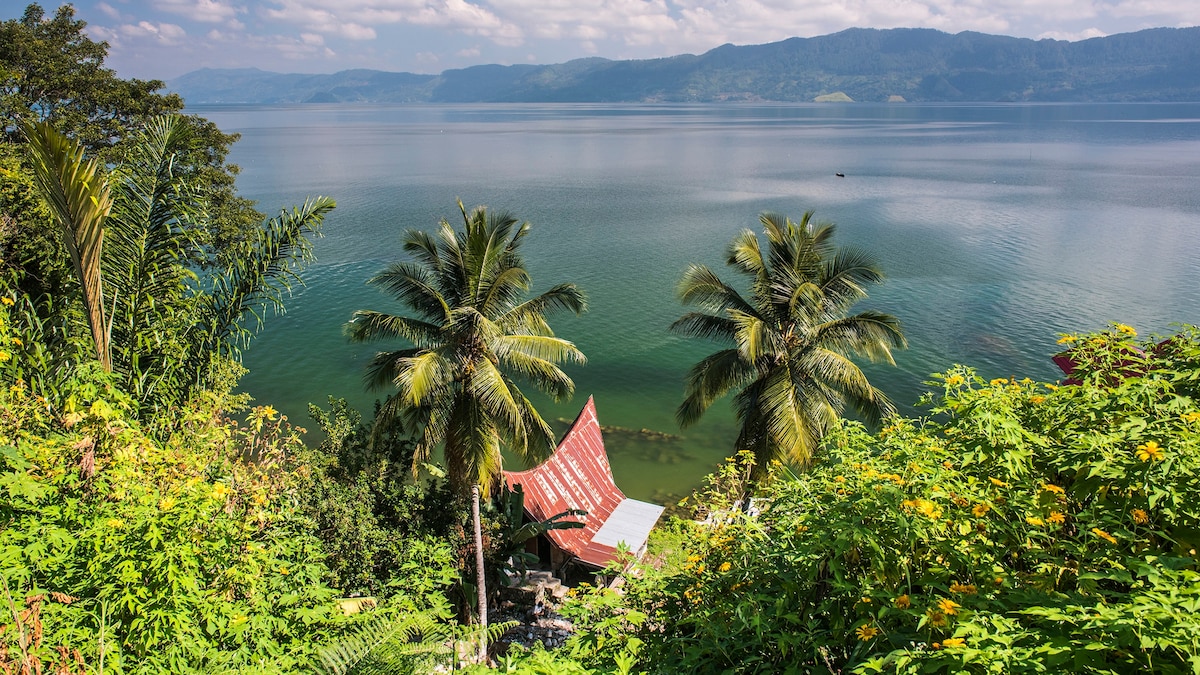It’s the sheer size and beauty of Lake Toba which strikes you while coasting along in a ferry towards the island of Samosir. Mountain greenery rolls down to the lake’s edge and a coolness in the air seems unlike anywhere else in Indonesia.
Just hours earlier we had landed at the relatively new Silangit Airport and walked out into the enervating air and energetic frenzy of a small Indonesian metropolis. While exciting, our saving grace was discovering a rather handy fixed-fee taxi service that would take us to the ferry.
Now we had positioned ourselves right at the front of the ferry and we were drinking in the cooler, lung-cleansing crisp mountain air after a few days in Jakarta. As the ferry gently pushed through the water, first impressions revolved around the scenery and the fact we were heading to an island in a lake that was nearly the same size as Singapore.
At over 1,145sq km, and up to a depth of 450 metres in places, Lake Toba is actually more like an ocean. It is the world’s largest crater lake as well as being the largest lake in Southeast Asia and one of the deepest in the world.
We had caught the ferry from Parapat which is the primary crossing point to Samosir on Lake Toba’s foreshore. On arrival in Samosir, we were immediately struck by the contrast between it and the Indonesia we’d left behind just one hour away.
The island has a magical almost otherworldly quality and seems far-removed from the usual hubbub of Indonesia. Its laidback vibe contributes to it being extremely easy to get around whether by car or bike. We visited the villages of Tomok and Tuk Tuk and found them ideal places to sample local food, shop in the markets and scope out accommodation if we chose to stay on the island overnight.
Just a stone’s throne
While staying overnight is ideal, so you can wake to the beauty of a Lake Toba sunrise, a day trip does provide plenty of opportunities to explore. Spend time meandering along the island’s roads taking in the scenery through rice fields and small farms with occasional stops in villages to buy local wares or learn a little about the island’s Batak culture.
For example, in Ambarita Village in the Simanindo District on Samosir Island lies Huta Siallagan – an ancient village which strongly radiates the unique culture of the Batak ethnic group. Huta means village so the name translates as the village of Siallagan. It’s a small stone-walled compound covering an area of 2400 sqm and was built during the reign of the first Huta leader, King Laga Siallagan, then further expanded during the time of his heir, King Hendrik Siallagan.
Interestingly, a number of descendants of King Siallagan still reside in Ambarita Village and the tombs of their ancestors can still be found in the area.
Inside the village you can explore a number of well-preserved Batak structures – as well as marvel at the stone chairs and table of King Siallagan carved from rock known as Batu Persidangan (stone for meetings and trials). Sitting under a Hariara Tree, it’s here where locals once met to discuss all manner of issues concerning the welfare of the village and its people.
There are actually two types of Batak house or Ruma – a structure with walls known as a Bolon used as a home and the Sopo which has no wall structure and usually functioned as a multi-purpose hall or harvest storage facility.
Captives were really in the soup
King Siallagan’s stone chairs and table was also the spot where local trials took place and (on occasion) a place where a guilty party might have found themselves as part of a nightly degustation menu. Local stories suggest a few overly-eager early Christian missionaries may have ended up on a nightly menu until one successful German missionary, Ludwig Ingwer Nommensen, successfully translated the New Testament into the Batak language and was spared. Some of his teachings spread across the island and you can see this legacy in a number of picturesque timber churches dotting the landscape.
If you are on a day trip, try and leave around sunset so you can watch the last colour of the day drain from the sky over the lake and surrounding landscape with the island as your backdrop.
Beyond Samosir Island, Lake Toba’s attractions are myriad and your ability to take them all in really depends on how much time you’re spending in the region. There are numerous spectacular hiking trails where you can either wander through volcanic moonscapes or embrace your inner Von Trapp and run through the alpine-like meadows singing show tunes. There is even an opportunity to “take the waters” as my Grandmother used to say and bathe in the revitalising waters of Sipoholon Hot Springs.
One of the most awe-inspiring experiences of all is a visit to Sipiso-Piso waterfall in the highlands of North Sumatra. Fed by a small underground river off the Karo Plateau, the lush surrounding landscape and the impressive force of the 120-metre drop fills you with wonder.
Getting there is a bit of a trek along winding and sometimes bumpy roads but the landscape along the way is jaw-droppingly beautiful in some places. On arrival though, we realised the drive was more than worth it. From numerous vantage points, the views back across Lake Toba are extraordinary and you really get a feel for its sheer size. More awe-inspiring is realising the lake is a vast crater blown out of the earth’s crust tens of thousands of years ago.
And after a long drive and eventual hike down to the base of the falls, standing in the cool mist while feeling the force of the water smash into the rocks at the bottom is thoroughly therapeutic. Importantly, after gorging on local fresh fruit and feeling completely refreshed, we were primed to make the return journey and continue our Indonesian adventure.
